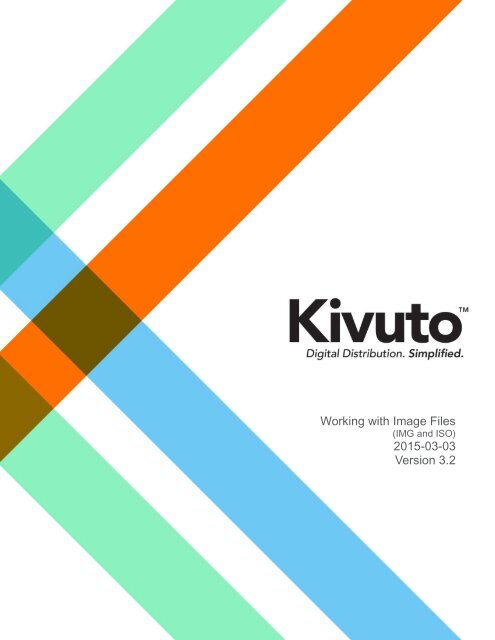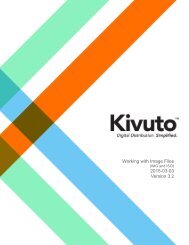Working_with_Image_Files.pdf
You also want an ePaper? Increase the reach of your titles
YUMPU automatically turns print PDFs into web optimized ePapers that Google loves.
<strong>Working</strong> <strong>with</strong> <strong>Image</strong> <strong>Files</strong>(IMG and ISO)2015-03-03Version 3.2
TABLE OF CONTENTSISO and IMG <strong>Files</strong> ......................................................................................................................................... 2What is an IMG or ISO File? ............................................................................................................... 232-Bit vs 64-Bit .................................................................................................................................... 2Bootable Installation Packages ..................................................................................................................... 3Package? <strong>Image</strong>? Disk/Media? .......................................................................................................... 3Bootable Installation Package ............................................................................................................ 3What do I do <strong>with</strong> My Installation Package? ....................................................................................... 4Creating Bootable DVD Media ...................................................................................................................... 5Requirements ...................................................................................................................................... 5Obtaining Free DVD-Burning Software ............................................................................................... 5Launching the Burning Software ......................................................................................................... 5Selecting the <strong>Image</strong> to Burn ............................................................................................................... 5Burning the DVD ................................................................................................................................. 7Installing your Software....................................................................................................................... 8Creating Bootable USB Media ...................................................................................................................... 9Requirements ...................................................................................................................................... 9Procedure ........................................................................................................................................... 9Installing your Software..................................................................................................................... 12
ISO and IMG <strong>Files</strong>WHAT IS AN IMG OR ISO FILE?An IMG or ISO file is a complete image of physical media such as a CD-ROM, DVD, floppy disk, etc. thatcontains all of the files in a particular package.32-BIT VS 64-BITMany packages are offered in both 32-bit and 64-bit versions. In the case of Windows 7, this applies to allof the Home, Premium, Professional and Ultimate editions. License keys provided for any of theseeditions will work for both 32-bit and 64-bit versions. The choice of version is up to you and is directlyrelated to the ability and compatibility of your hardware.To run 64-bit versions, your computer hardware must support 64-bit applications for this product tofunction. Refer to your manufacturer and/or retailer for specific information regarding the capabilities ofyour hardware, and consult your WebStore’s Help page for details on how to determine which version ismost appropriate for your computer.Important: If you are planning to upgrade from an existing 32-bit Operating System to the 64-bit version,you must use Custom Install as the Upgrade Install option may not be available.<strong>Working</strong> <strong>with</strong> <strong>Image</strong> <strong>Files</strong> | 3 March 2015 | 2
Bootable Installation PackagesPACKAGE? IMAGE? DISK/MEDIA?This document refers to installation packages, installation images and installation disks. These items aredefined as follows.Installation Package: what you purchase from the WebStoreInstallation <strong>Image</strong>: the content of the installation packageInstallation Disk/Media: what you produce from the installation image through the burningprocessBOOTABLE INSTALLATION PACKAGEThe bootable installation package contains a disk image that is identical to the boxed product that youwould purchase at any software retail outlet. This image may be burned directly to physical media toproduce a bootable installation DVD.Once copied to physical media, this package may be used to install an Operating System on anycompatible hardware, <strong>with</strong> or <strong>with</strong>out an existing Operating System installed.<strong>Working</strong> <strong>with</strong> <strong>Image</strong> <strong>Files</strong> | 3 March 2015 | 3
WHAT DO I DO WITH MY INSTALLATION PACKAGE?Your installation package contains one of the images identified in the previous section. To install anysoftware package from an image, the image itself must first be “mounted” by the Operating System. Thiscan be accomplished by:Burning the image directly to DVD <strong>with</strong> the source type specified as “image”. Once the burning ofthe image is complete, the physical media can be inserted into the computer and will berecognized like any other DVD. You must have a writable DVD drive. See the Creating BootableDVD Media section.Burning the image directly to a USB flash drive. This is particularly useful for those people whohave Netbooks or other computers <strong>with</strong>out a writable DVD drive. See the Creating BootableUSB Media section.Note: Burning the file to a disk as a “data disk” will simply end up <strong>with</strong> an IMG or ISO file on the disk,which cannot be used for the installation.<strong>Working</strong> <strong>with</strong> <strong>Image</strong> <strong>Files</strong> | 3 March 2015 | 4
Creating Bootable DVD MediaREQUIREMENTSTo prepare physical media from a bootable installation image, you require the following: The bootable Installation image (i.e. the IMG or ISO file) A writable DVD drive (DVD-R, DVD-RW, DVD+R, DVD+RW) A writeable DVD media CD/DVD Burning Software (Roxio©, Nero ©, Active@ ISO Burner, etc.)OBTAINING FREE DVD-BURNING SOFTWAREIf you do not already have an application to burn files onto a DVD, you will need to download a freewareversion.This document describes the process using Active@ ISO Burner (available through NTFS.com athttp://software.lsoft.net/IsoBurner-Setup.exe). This is the application that we recommend you use.However, the same general process described in this document should apply regardless of what softwareyou choose to use, as most CD/DVD burning tools share a similar interface.LAUNCHING THE BURNING SOFTWARETo launch the burning software:1. Click Start.2. Click Programs (or All Programs, depending on your version of Windows).3. In the list of programs, click Active@ ISO Burner. The program is launched.SELECTING THE IMAGE TO BURNTo select the image to burn:1. In the Active@ ISO Burner window, click on the locator box as shown by the red arrow.<strong>Working</strong> <strong>with</strong> <strong>Image</strong> <strong>Files</strong> | 3 March 2015 | 5
2. Find and select the IMG file you downloaded.Note: Frequently files are downloaded to C:\temp. If you find two subfolders for thesoftware - one for the 32-bit version and one for the 64-bit version, be sure to choosethe appropriate version for your machine. Consult your WebStore’s Help page forinformation on the difference between 32-bit and 64-bit software.3. In the “<strong>Files</strong> of type” drop-down list, select the CD/DVD <strong>Image</strong> File(*.img) option. The IMG file isdisplayed in the window. If you wish to burn an ISO file, choose the CD/DVD ISO image (*.iso)option.<strong>Working</strong> <strong>with</strong> <strong>Image</strong> <strong>Files</strong> | 3 March 2015 | 6
4. Double click on the file. The Active@ ISO Burner window is displayed.BURNING THE DVDMake sure the disk you are using is a DVD and not a CD. Also, make sure that you are using a DVDburner, as a CD burner will not work <strong>with</strong> this process.To burn the DVD:1. Place a blank DVD into the DVD drive.2. Click the Burn button. The progress of the burn is displayed near the bottom of thewindow.<strong>Working</strong> <strong>with</strong> <strong>Image</strong> <strong>Files</strong> | 3 March 2015 | 7
3. When the disk is ejected, click the red X at the top of the window to close theprogram.You now have a copy of the software and are ready to install it.INSTALLING YOUR SOFTWAREOnce your installation disk has been burned, navigate to the root of the DVD directory and double-clickthe file Setup.exe to launch the installation of your software.<strong>Working</strong> <strong>with</strong> <strong>Image</strong> <strong>Files</strong> | 3 March 2015 | 8
Creating Bootable USB MediaREQUIREMENTSTo create a bootable USB flash drive, you will require:Bootable Installation image (i.e. the IMG or ISO file)A USB flash drive <strong>with</strong> at least 4 GB of storage spaceNote: Any existing data on the USB device will be lost. Ensure that you have backed upany important information.The Windows 7 USB/DVD Download Tool (WUDT)WUDT runs on Windows XP, Windows Vista and Windows 7, and supports localized language versionssuch as German, English, French, Italian, Simplified Chinese, Hebrew, Arab, Czech, Danish, TraditionalChinese, Norwegian, Japanese, Korean, Dutch and Spanish.PROCEDUREThe following instructions were adapted from a tutorial found on MyDigitalLife. Refer to this tutorial if yourequire more information.To create bootable USB Media:1. Download the IMG or ISO file.2. If you downloaded an IMG file, change the extension to .ISO before proceeding.Note: To convert an IMG to an ISO:i. Open the folder where your IMG file is located.ii.iii.iv.Click: Tools » Folder Options. (Note: If you do not see a “Tools” menu at the top ofthe folder, press Alt to display it.)Click the View tab.Turn off the option Hide Extensions for Known File Types (if it is currently active),and then click: OK.v. Right-click your IMG file and click: Rename.vi.Replace the “.img” at the end of the file name <strong>with</strong>: “.iso” and then hit enter.3. Download and install the WUDT.<strong>Working</strong> <strong>with</strong> <strong>Image</strong> <strong>Files</strong> | 3 March 2015 | 9
4. Run the WUDT.5. In the Source file box, type the name and path of your ISO file, or click Browse and thenfind/select the file.6. Click the Next button.7. Click the USB device button:8. Click the Next button.9. Insert a USB flash drive into one of your computer’s USB port.Note: Make sure that no important data is stored on the USB device as it will be formatted when<strong>Working</strong> <strong>with</strong> <strong>Image</strong> <strong>Files</strong> | 3 March 2015 | 10
you start the copying process and all data will be lost.10. Select your USB device in the dropdown list and click Begin copying. The WUDTwill format the storage media and then copy the ISO over to the media.<strong>Working</strong> <strong>with</strong> <strong>Image</strong> <strong>Files</strong> | 3 March 2015 | 11
Once the bootable USB device has been successfully created, you are ready to install your software.INSTALLING YOUR SOFTWAREOnce your USB media has been created, navigate to the root of the USB drive and double-click the fileSetup.exe to install your software.<strong>Working</strong> <strong>with</strong> <strong>Image</strong> <strong>Files</strong> | 3 March 2015 | 12




